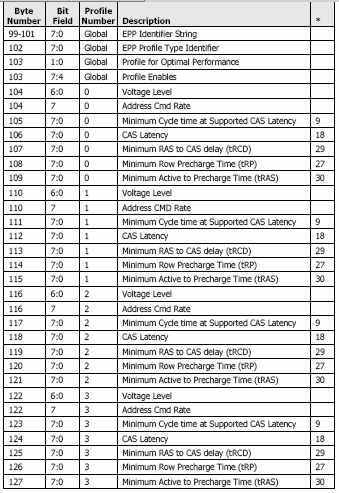Wednesday, February 21, 2007
What is Enhanced Performance Profiles (EPP)?
DDR2 DIMMs with Enhanced Performance Profiles has been around since last year and widely adopted by the gamers and over-clock enthusiasts. It is a collaborative memory development effort by nVidia and Corsair Memory to allow users to easily expose the advanced memory configuration settings for higher levels of system performance.
Extended Serial Presence Detect
Each DDR2 DIMM comes equipped with a 256-byte EEPROM that used to store Serial Presence Detect (SPD) information defined by JEDEC council. The SPD information includes the said module’s serial number, part number, and especially the timing parameters that are required to booting up the system. Only a portion (byte 0 to 98) of the 256-bytes of the EEPROM is defined by the JEDEC SPD specification. http://www.simmtester.com/page/news/showpubnews.asp?title=DDR2+DIMM+SPD+Definition&num=139
That leaves the rest of the bytes 99 to 255 open and usually unused by most module makers. EPP take advantage of this open space by storing the memory configuration settings in bytes 99 to 127 to optimize and maximize system performance.
EPP SPD Defination Byte 99 - 127

What is the benefit ?
Before the creation of the Enhanced Performance Profiles, users who buy any hand-picked high rated memory have to have some knowledge of over-clocking know-how in order to tweak and set the said high performance memory to operate at the desired speed.
The new Enhanced Performance Profile (EPP) SPD specification was designed to eliminate that hassle. When target system reads and recognizes the new and advanced Enhanced Performance Profiles memory settings, it will automatically execute at the highest overall speed possible.
Two Profiles
Memory module makers can specify two sets of Enhanced Performance Profiles. These profiles include two full or four abbreviated profiles of SPD.
The difference between full and abbreviated profiles is the former contains detailed information such as drive strength for address, CS, clock, data, DQS signals, address/command fine delay, setup time, CS delay, write recovery, and active refresh. Whereas the latter only contains memory voltage, command rate, cycle time, CAS latency, tRCD, tRP, and tRAS.
This is very useful as manufacturers can now have two predefined profiles for the memory modules - conservative and aggressive timings.
What is change?
While memory modules with Enhanced Performance Profiles will work on any motherboard, only motherboards equipped with specially-designed BIOS will detect the presence of these new settings and prompt the user to set PC boot parameters for best possible performance.
Not yet a JEDEC Endorsed Specification
Enhanced Performance Profiles were developed as an open standard and the proposal had been submitted to JEDEC for approval. Nevertheless, JEDEC SPD group did not officially endorse such standard by issuing the following statement to memory manufacturers:
"EPP is not a JEDEC endorsed specification and should not be misconstrued in the industry as such. I do encourage the sponsors of the concept, or any other companies wishing to properly document higher DDR2 speed grades, to develop a truly open specification by submitting a proposal to the JEDEC committee and to the SPD Task Group and following the well established guidelines by which open standards are developed."
Summary
It is believes that placing EPP settings in the SPD would enhance the overclocking experience for all users. Aside from Corsair, other memory module manufacturers like Corsair, OCZ Technology, Kingston, Crucial etc have also offered hand-picked high performance memory modules with EPP setting.
DDR2 DIMM EPP Specification_v01.pdf
General disclaimer: This page only reflects the author personal opinion and assumes no responsibility whatsoever regarding any of the contents or any damages that may occur explicitly or implicitly from reading the contents of this site. All names and trademarks mentioned in this review are the exclusive property of the respective parent companies.
By: DocMemory
Copyright © 2023 CST, Inc. All Rights Reserved
|


